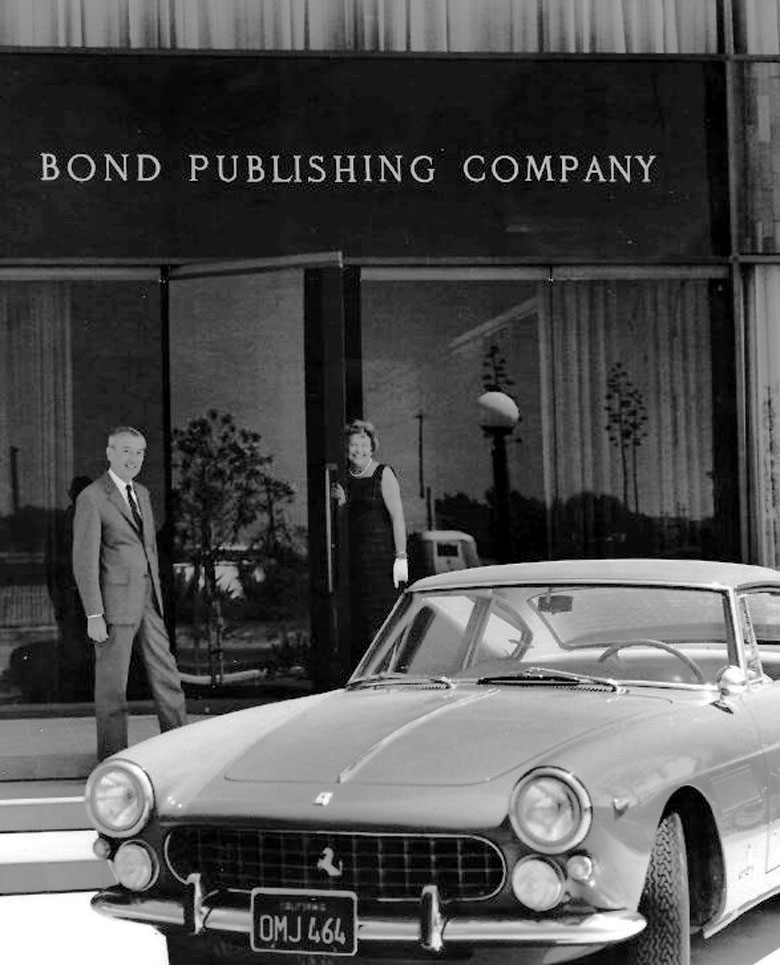
The Bonds in front of the R&T offices with their Ferrari 330GT, 1964.* Courtesy Marilee (Lee) Bond Nudo
By Pete Vack with Jim Sitz, John R. Bond, Jr. and Marilee (Lee) Bond Nudo
John Bond took over a distressed Road and Track in the fall of 1952, but always admitted that Elaine was the brains of the outfit. David E. Davis wrote (C&D Nov 1990) that she “…was the ramrod that turned R&T into the magazine it was in the Sixties and Seventies.”
Right from the start, the Bonds knew that an American automobile magazine had to be different than the conservative and often boring English magazines such as Autocar. Boring though it may be, John liked the Autocar’s road tests, and used them as a model for their own road tests, which were the first in the U.S. Davis recalled that “Elaine admired the New Yorker magazine immensely, and the New Yorker** became their model. Their Road & Track combined the subject matter of English car magazines with the sly wit and understated elegance of the New Yorker. It was a brilliant plan, and it resulted in a brilliantly successful magazine.”
Davis and Bond were friends, but a lapse in their relationship would eventually help improve one of Road & Track’sfiercest competitors, Car and Driver. Wrote Bond, “I met DED in 1955 and we hired him to work for us as advertising director.” Bond later fired him. “I suppose that was my most famous faux pas.” DED proved to be formidable competition and was very successful.
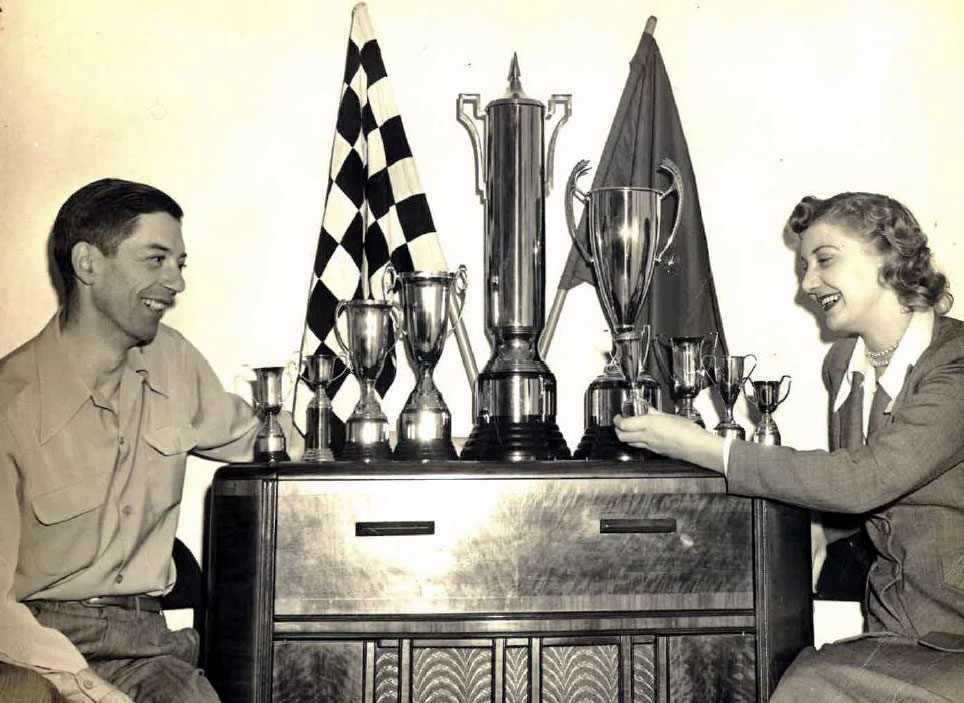
John and Elaine Bond admire Elaine’s racing trophies, circa 1952. Courtesy the John Bond Jr. collecton.
Jim Sitz was close enough to the Bonds to learn about how John and Elaine Bond met. “Elaine was Elaine Williams, who had been married before WWII and had a daughter named Lee. In fact both Elaine and John had been married before. John too had married before the war — a lady named Mercedes, when they both worked for Studebaker in Indiana. But during the war, he got a ‘Dear John’ letter from her.”
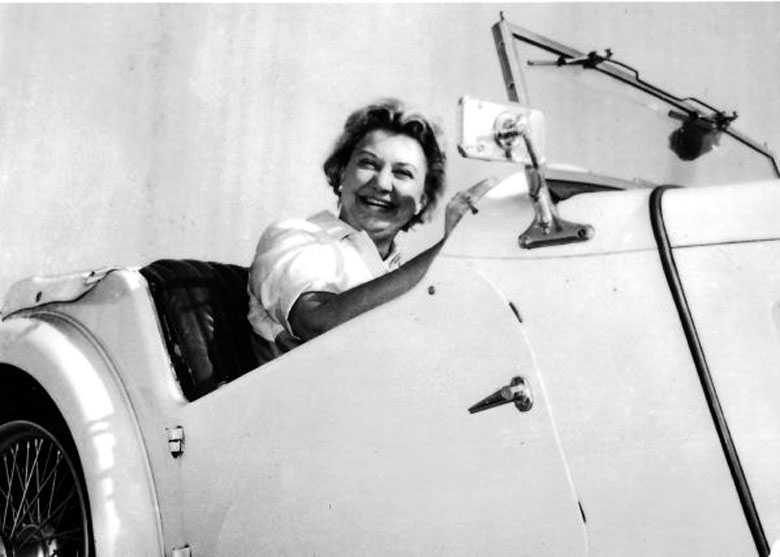
Elaine and the MGTC. When Elaine became pregnant she no longer fit into her prize MGTC. “A few years later John got another one, and restored it and surprised her with it,” recalled Sitz. “It was a nice gesture.” His book, Sports Cars in Action, was published in 1953, and dedicated to “Elaine, who felt the TC was the better MG.” Courtesy Marilee (Lee) Bond Nudo
In 1948 Elaine had been an assistant to Glen Gordon “Gary” Davis when he was building his three-wheel car in Van Nuys. Sitz said “She got him to let the Cal Club use the company’s test track for a speed event, during which she drove Phil Hill’s MG. She dinged a fender, and the future World Champion never let her forget it!” By 1949 she entered her own MGTC in local events, where she was noticed by John Bond, who was reporting on the SCCA Rose Bowl Rally for the new SCCA magazine, and commented on a certain Elaine Williams, who was going fast and furious in her TC. Later that year after a victory dinner at the Lamplighter Restaurant in North Hollywood after the Goleta Time Trials in September, John got up the courage to ask her for a date. The couple married in 1950, and said Sitz, “Their honeymoon was driving to Watkins Glen in John’s new Ford.” The 1950 Ford was a step up. “When I first got to know John, I had a ’41 Chevrolet coupe, he had a ‘40 convertible. They were $100 cars. At the time, Bond’s automotive aspirations were to own a Lancia GT and a Ferrari 340 America.” Eventually, Bond bought an old 166 MM Ferrari, then ordered his first new Ferrari in 1963, a 330 GT coupe.” According to John Jr., “Dad ordered a 1964 model 250 GTE 2+2, which turned out to be one of the last 50 cars of this model. But when he and mom visited the factory to pick it up, he was surprised to learn from Enzo that the car came factory-equipped with the new model 330 engine. Dad was thrilled — he knew it was a better engine.”
Marilee (Lee) Bond Nudo
Elaine’s daughter Lee sent us a John Lamm photo of a Talbot Lago. While Elaine liked her TC and later her Mercedes 6.3, Lee says “The car pinned on the wall behind her desk was a photo of the car she thought the most beautiful – a 1938 Talbot Lago Figoni et Falaschi.” Jim Sitz thinks he knows why. “Obviously Elaine was impressed with the pair of Talbot Lagos at that 1948 Davis speed trial, the same event where she drove that Phil Hill MG. The Talbots were driven by Roger Barlow in the silver blue Lago with white sidewall tires, and von Neumann in the dark green Talbot, both purchased from the Tommy Lee collection..
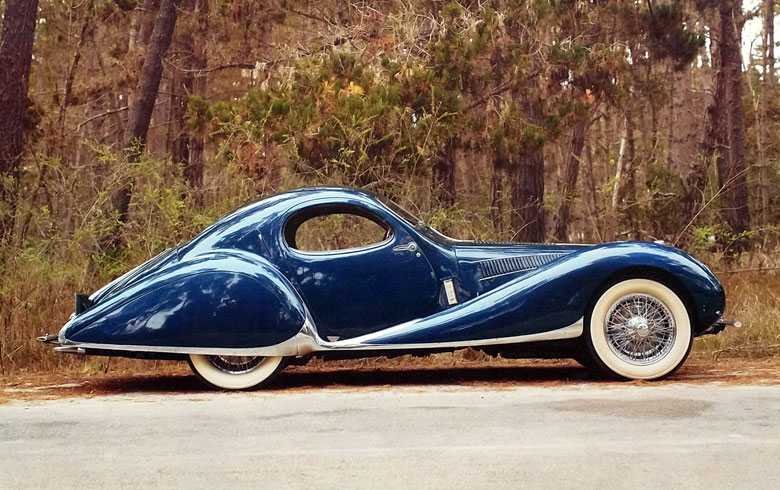
Recalled Lee Bond, “Mom drove the heck out of her 6.3 Mercedes (she was always know as a “lead-foot”), but the car pinned on the wall behind her desk was a photo of a 1938 Talbot Lago Figoni et Falaschi by the late John Lamm. Sooooo elegant. Elaine’s favorite car.” Courtesy Marilee (Lee) Bond Nudo
But racing was dangerous and as Lee recalls, “In the early days, mom and dad attended a lot of road races – sometimes with us in tow, but most of the time on their own. There came a point, however, when they stopped attending in person. I wish I could tell you when that was, but I can’t. Mom simply told me they couldn’t do it anymore because too many of the drivers were personal friends.” Sitz agrees. “Knowing the drivers personally, the death of Ernie McAfee was a real blow to all us, and several racers did retire after his death. It had to affect the Bonds.”
The good years came with a fantastic surge in sales of small imported cars like VW, Renault, and Fiat and the increased advertising that accompanied it. “When I came home from Europe in 1957, they took me to lunch in their new white Jag 3.4 sedan, and had just hired new boy Dean Batchelor,” said Sitz. By 1963 the company moved into new and impressive digs on Monrovia Avenue in Newport Beach. According to Lee Bond, “They worked together so closely that when they built their new R&T office building in Newport Beach, they shared one large executive office. That way they could easily communicate throughout the day. Later, when they retired to Escondido, CA, and had a much smaller, home office their desks were butted up against each other – face to face.”
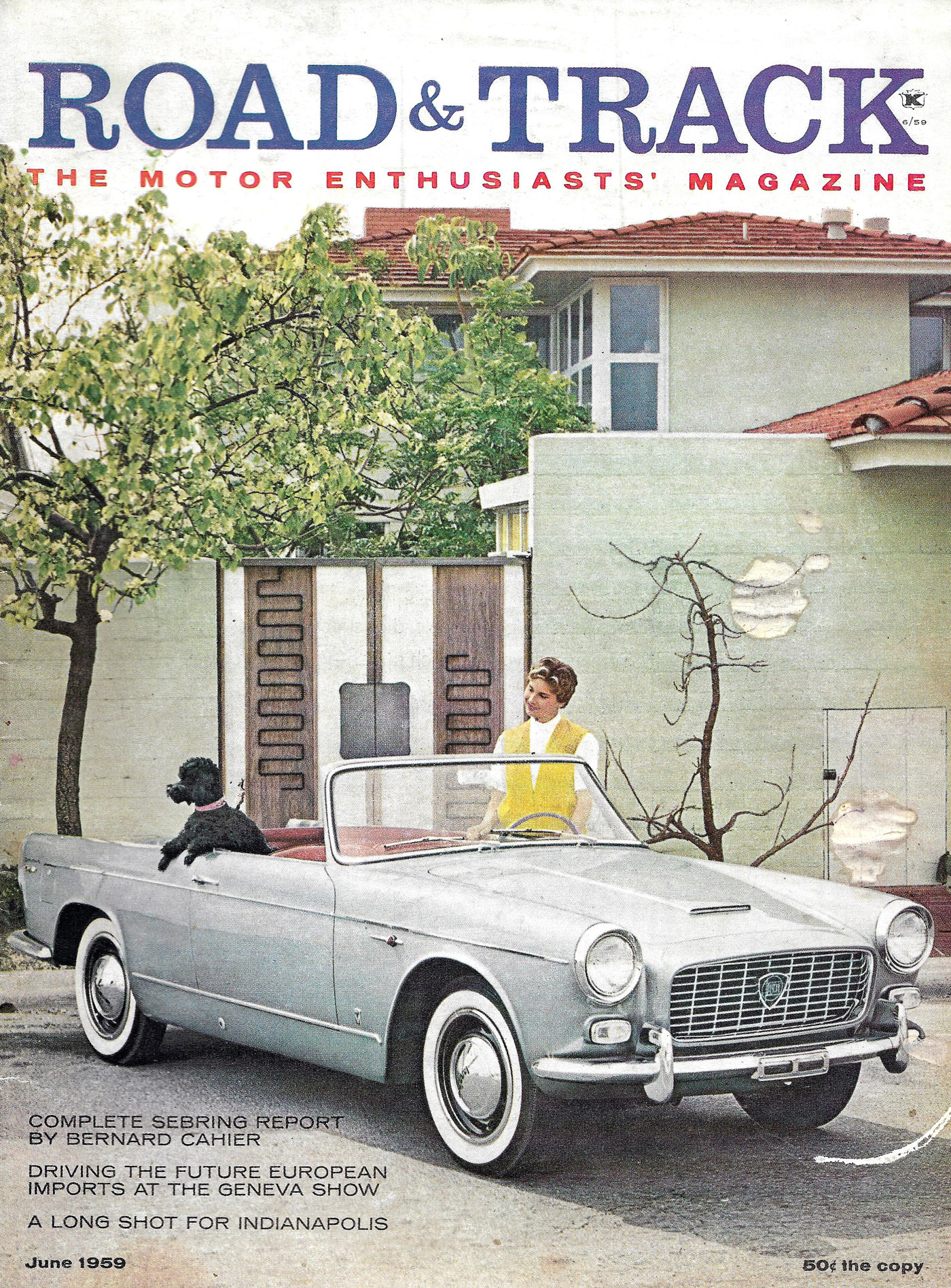
Said R&T: Our international salute to spring includes a French poodle, an American girl, and an Italian car. The poodle is Henry Higgins, our models is the publisher’s daughter, Lee; and the car is the new Lancia Appia four seater convertible. Ektachrome by Ralph Poole.
Bond never stopped being an engineer, continuing his Miscellaneous Ramblings, Sports Car Design Number.. …and often bringing his ideas home. Lee Bond had a few amusing memories of an engineer whose mind never stopped wanting to change and/or improve things. “My first car was a 1960 Ford Falcon Ranchero (which could hold surfboards in the bed). I wanted to lower it in front, as was the style of that era, but my dad wouldn’t hear of it. ‘NOT SAFE!’ he said. So he had it lifted in the rear. It worked.
“Later, when I purchased an old 1952 Studebaker pickup, there was something he didn’t like about the transmission, so he put “3-on-the-floor” for me. I don’t know why. He was simply always thinking of and drawing ways to make things more efficient – or maybe more fun.”
John Bond Jr.
Noted in the July 1952 issue of Road and Track, was a short announcement in the editorial slot:
“New Tech Ed” The repercussions may not be felt for many months, or even years to come; but an event transpired the other night which will quite likely lead to the displacement of Road and Track’s Technical Editor. John Bond, one of the most respected men in automotive circles, has been making a valuable contribution to the enlightenment and entertainment of enthusiasts and authorities. But another fellow arrived May 7th who may prove to be a serious threat to J. B. His name is John Bond, Junior. He weighs 7 ½ pounds, is reported to have a favorable power to weight ratio, and will (according to Mrs. J. B.) remain absolutely stock—as delivered, F.O.B.
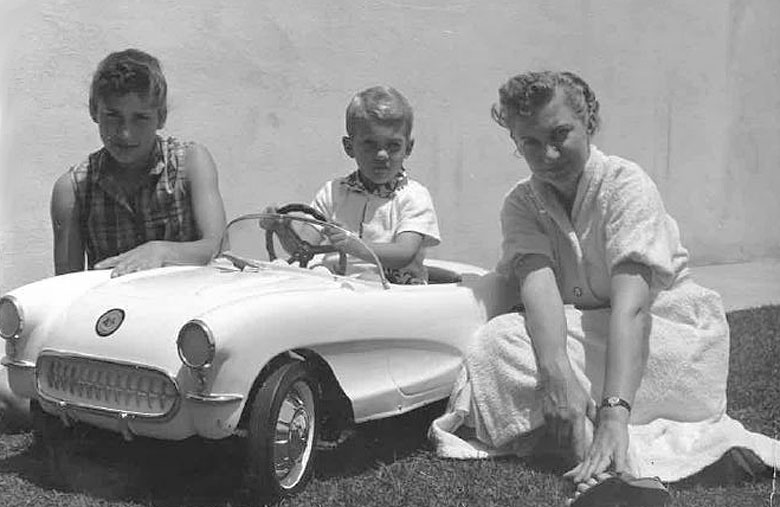
Bond Jr. in a Corvette pedal car, circa 1956-7. His sister Lee is on the left, Elaine on right. Courtesy of John Bond Jr.
Bob Gurr, (email, 3-15-21) who would often do artwork for the magazine, recalled Bond Jr. as John and Elaine loved spoiling the new arrival. “When they lived in Pasadena, they’d invite me over a couple of times a month, usually after dinner where John Sr. would continue the long cocktail hour. They had a low table in the living room where John would pile the latest technical papers among the martini glasses. John Jr., in learning to walk, would try walking on the table between the papers and cocktails…sometimes with unfortunate results. John and Elaine never made much fuss over that.”
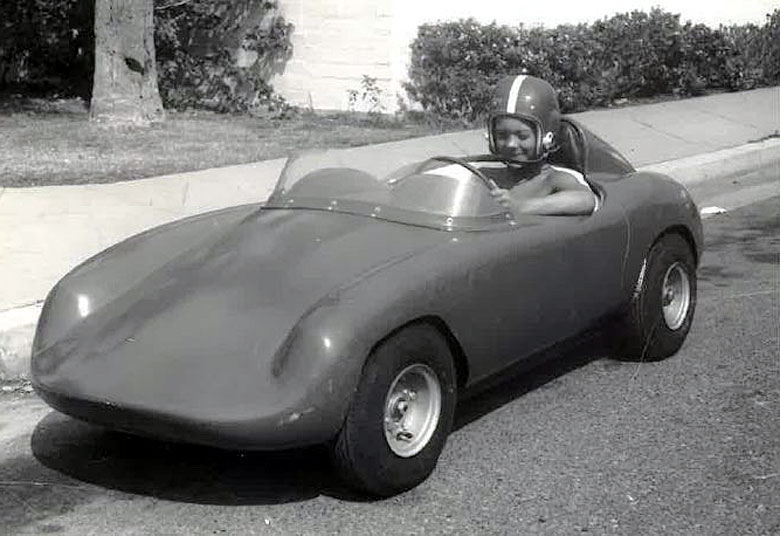
Bond Jr. circa 1961 with a Ferrari Monza Go Kart (Devon). “No Baby Bugattis here!” recalled Bond. Courtesy John Bond Jr.
We contacted Bond Jr, for this article to get his insights. The first thing he said was “…the absolute biggest thing my father did to make the magazine successful was to marry my mother! My dad would have never even bought the magazine without her encouragement and her contacts.”
Bond Jr. recalls that Charles Gillet had a significant impact on the fortunes of the magazine. While David E. Davis attributed the New Yorker style to Elaine Bond, the originator may have been Gillet, who became associate editor in 1954, and got the job by showing up at the office with a copy of Road and Track having blue lined the typos and errors he had spotted. He also suggested making the magazine “…the New Yorker of the automotive press.” (R&T June 1997). The Bonds fully agreed and made Gillet a new associate editor, just under Bond himself as editor. John Bond Jr. recalls that as a young boy he knew him as an uncle figure, and that under Gillet the magazine really prospered, helping pay off that costly promissory note. Jim Sitz said that after Gillet left the now named Road & Track in 1957 he went back home to Maryland and started a very successful Volkswagen agency.
But the magazine was succeeding and in October of 1955 Bond went to Paris and London for the Motor shows. Recalls Sitz, “I still remember Elaine telling him he had to go, even though money was short and yet she insisted he did so, good for business. Accompanied by friend Bob (Henry) Gurr they also did the factories at Ferrari, Mercedes and Porsche on this special tour. Bond would joke, ‘Try and get me back to Glendale.’”
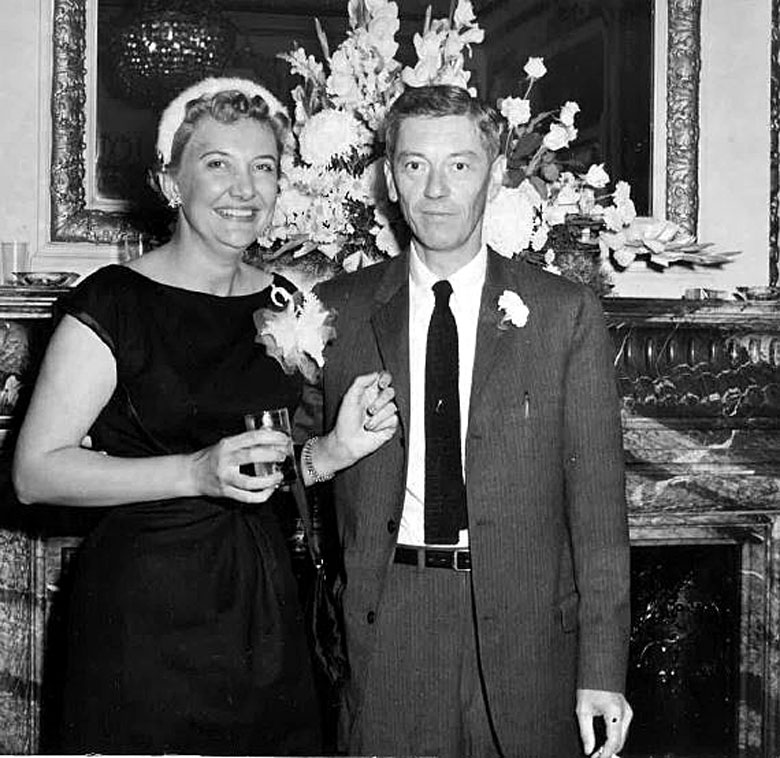
John and Elaine at the NY Plaza during one of early trips to New York Auto Show. Courtesy John Bond Jr. Collection
Bob Gurr has unforgettable memories of that trip. “Sometime in summer 1955, John was part of a small group planning a visit to Europe. Elaine threatened me with the fact that if I didn’t go with John then, I’d never get there, as I would be married with kids before too long. So I got time off from my new Disney job and went.
“It was early October, the week after James Dean died. Itinerary was amazing; Paris Auto Show, demo drives in the radical ’55 Citroen DS-19, lunch with Bernard Cahier. Then a visit to the then moribund Bugatti works, on to Porsche and Mercedes. I got to meet Ferry Porsche, he let me sit in his President’s chair! We all got to take the new speedsters out to an autobahn lunch place where “Racing Baron” Huschke von Hanstein gave us all 120 MPH rides in their new 550 Spyder. (My photos are in the Rasmussen Porsche book.)” Bond Sr. wrote of that trip: “My only visit to Porsche was in 1955. Von Hanstein was their racing director and Elaine and I met him everywhere, from Sebring to Le Mans. He always kissed her hand, his mustache tickled, she says. Okay, so our son and daughter each have Porsches, if that tickles your fancy.”
In 1972 Bond Sr. wrote “Road & Track’s growth wasn’t spectacular, but steady…In the past 20 years our annual revenues have increased from $150,000 to about $4 million. Mom and Pop now have a fairly large family and a lot more responsibilities along with it.” In that same year, the Bonds sold out to CBS Publications. It was the end of an era.
Lee commented on her parents: “Their life together was totally complete – they absolutely loved their work. It was everything to them and seemed to fulfill all their needs. At least it felt that way to me. I think both my brother and I would’ve loved to spend a little more family time with them, but we were, and are, immensely proud of them. And to this day, we both LOVE cars – their looks and their sounds.”
_____________________________________________
*Two Editors, Two Ferraris
Disclaimer: This is a case of simple coincidence and not in any way to be misconstrued or inferred that VeloceToday’s Editor and the esteemed Road & Track Editor and Publisher John Bond have anything in common aside from each owning one of the 50 Ferrari 330GT Americas.
After establishing a secure financial footing for the magazine, John Bond, as conservative as he was, decided to splurge and order a new Ferrari. As son John Jr. recalls, he put in an order for a single headlight Pininfarina 250GT, but happily found out that he would actually get one with the 330 engine. The last fifty 250 GTs were really 330GTs and called “Americas” and unlike the later 330, retained the earlier body with the single headlights. They also featured driving lights. Bond took delivery of the 47th one built, serial number 5109 GT. He sold it some year later, asking $8,500.
In 1973, roughly ten years after Bond took delivery of his 330GT, VeloceToday’s future Publisher and Editor in was in possession of an Alfa 2600 Zagato for which he had paid the princely sum of $1800. He offered it for sale and soon someone came knocking with a deal; we’ll trade you even for a 250/330GT Ferrari America. The Alfa ran, the Ferrari didn’t. But the deal went through and soon this rare (at the time it was unknown how rare) Ferrari that refused to start was his. Another gent, Kyle Fleming, soon came knocking as well, and offered to take the Ferrari in trade for an Alfa 2000 Spider and enough cash to put down on a house. That deal too, went through. Fleming recalled that the Ferrari was parted out in August of 1977. The serial number was 5079 GT and it was the 42nd American built.
**The Editor of the New Yorker, Bill Shawn, enjoyed sports cars almost as much as John Bond. Lillian Ross recalls Shawn’s enthusiasm: “We bought a TR3 sportscar, in British Racing Green, and we bought a sporty black and white checkered cap for Bill to wear when driving it…..He loved driving the Triumph. He’d get behind the wheel, put on his checked cap, and off we’d go.”
From “Here but not Here” by Lillian Ross, Random House, 1998 Page 135

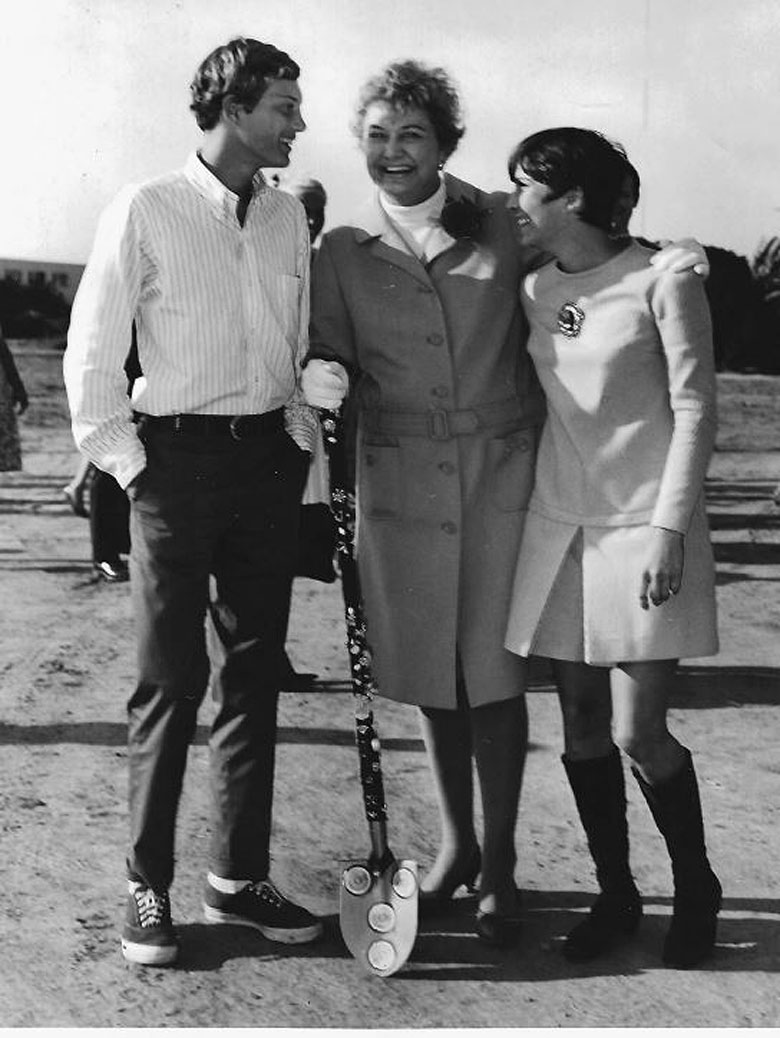
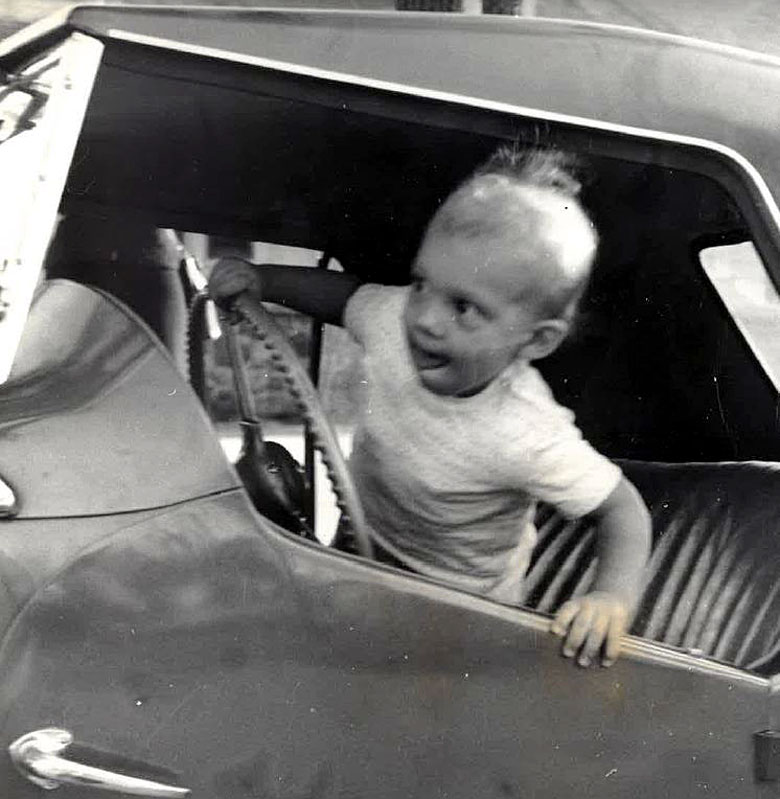
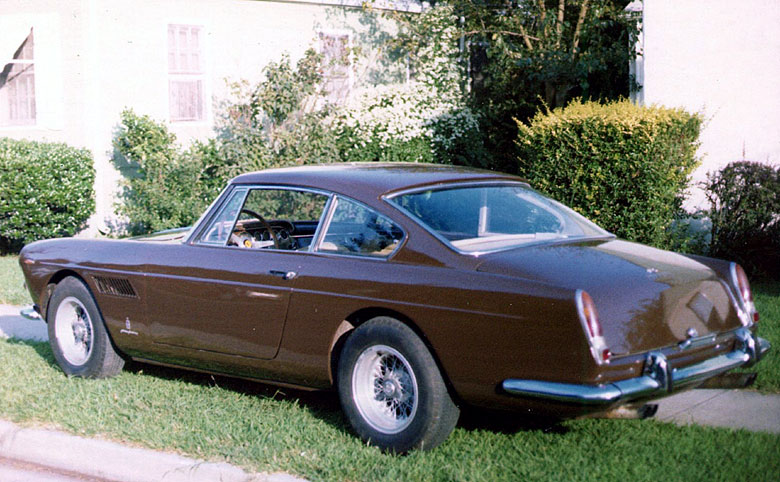
What a great way to start a morning. Sun flowing in, a hot cup of coffee, Miles & Gil Evans and great memories of Road & Track.
Thanks!
Mark Carmon
Thanks for a great story about the people who made my favorite car magazine. It was the first magazine I subscribed to. I didn’t know the story of how the magazine came to be and almost didn’t survive. The Bond’s were an incredible couple and this article really gives them their due.
I was a keen reader of Road & Track in the 80s.
The style was more easy-going than in similar French car magazines, but the technical level was top and the main focus on European performance cars.
Rob Walker and Innes Ireland reported about Formula 1, and Phil Hill tested top-notch classical sports and race cars. It’s still a joy to read him.
I’m not sure that the magazine kept the same level in recent years.
P.S.: in the 80s, R&D published an article about cheap Ferraris, i.e. the 250 GTE 2+2 and the 330 GT.
Two years ago, a 250 2+2 graced a booth on the Techno Classica in Essen, featuring a price tag of 500 000 EUR.
An understatement Ferrari with perfect proportions in elegant Griggio Chiaro metalizzato.
Had I bought one 40 years ago!
Terrific article, their literary style had me hooked, and from 1960 on I read issues cover to c0ver. Then in 2005 I went on a quest and found and purchased every issue back to
Vol. 1 No. 1, which is a reprint. Interesting library if you need to research something,
but otherwise lots of paper taking up space….
At one point I actually thought Peter Eagan was writing about my life?
I could never swing my attention to C & D, it just didn’t read the same….
Stay Safe!
Angelo
Thank you to all who contributed to the R & T article. Excellent. I had learned a lot of the information over the years from friend Jim Sitz, but kudos to Pete for pulling it all together and presenting it in such an interesting and informative way. R & T was certainly an important part of my upbringing in our sport, and I thank you for documenting the memories for such an important part of our history …
Great to see Charles Gillet mentioned. I met Charles after he sold off his VW franchise and got into the RROC with a prize winning pair of cars. One was a Phantom 1 , the other an R Type Bentley with a James Young body. Charles was always interesting and loved his cars.
I remember vividly riding my bike as a kid to a seedy establishment in Tampa that sold newspapers, magazines and cigarettes. I would spend an hour or so looking over every car magazine before selecting one, R&T. I also learned what the curtain was for that separated the car section from the dark area in back.
Back in the ’50s I used to get together at lunch break with the only other fellow in high school who I knew was a car enthusiast to see if one or the other of us had walked to the nearest magazine store to see if the latest Road & Track was in yet. Exciting times.
Thanks for the wonderful remembrance of the Bond family. I met them at the first Cunningham Automotive Museum cocktail party for the museum members. It was always a great event – black tie only and the Stan Kenton band to boot. I remember telling John that he reminded me of the famous pianist and movie actor Oscar Levant, right down to the ever present cigarette. He loved this and ushered me around to meet all of his friends in the business, and to ask them if they thought the same thing. We all laughed.
Wonderful man !
Dear Jim and Pete :
Many thanks for the fascinating and poignant story . The T-L is a lovely bonus !
Thank you for running the story. I started doing work for R&T in 1971 and continued until the move to Ann Arbor. It is nice to read the story of the Bonds. Very nice. Thank you.
My dad would bring home R&T magazines beginning in the late fifties. I literally grew up reading them. I loved the writing, the photography, the stories of men, cars, and great automotive events. As a kid from the Bronx, I really wanted to see those cars, visit those fantastic places, and meet those people. In a very real sense, John and Elaine had a huge impact on my entire life. I decided I had to be in the automobile business and for a European car company. As it turned out, I worked for two Volvo and Rolls-Royce. My career allowed me to do everything I had hoped for. Sadly, I never had the opportunity to meet John and Elaine. Thanks to this article, I feel as if we had met!
Just another fabulous and inspiring Velocetoday article. Interesting and informative how the magazine endured and progressed thanks to the Bonds.
R&T was extremely valuable publication to me as I was a high line English import sales associate, and later German import, in the 70’s and 80’s. With its objective road tests and comments on the vehicles I represented, and those of its competitors, it gave me increased vehicle knowledge and leverage.
My first purchase of a R&T magazine in 1963, was a little overwhelming as its higher cost than my usual Hot Rod or Car Craft was. I was an avid subscriber for years and now receive quarterly the current publishers magazine.